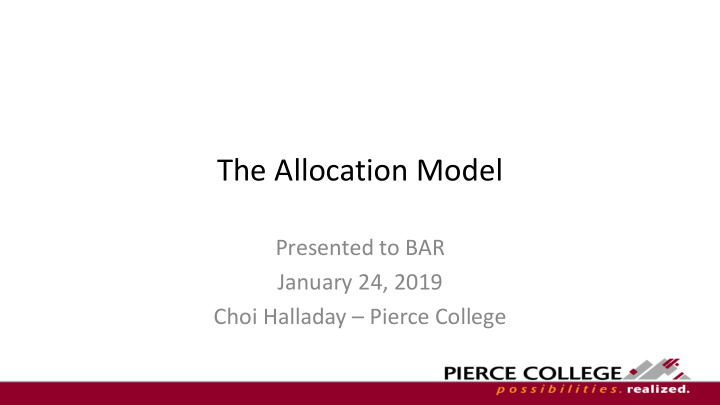



The Allocation Model Presented to BAR January 24, 2019 Choi Halladay – Pierce College
Allocation History • Base Plus Funding – Colleges receive prior year funding plus a share (if eligible) of new money – No clear way to make adjustments across districts – Average FTE funding dependent on when districts grew in FTE • Some years funding was very high per new FTE, some years really low • Accumulated large difference in per FTE Funding
Allocation System Principles Adopted by WACTC in 2014 An allocation system should: 1. Be stable 2. Be predictable 3. Be understandable 4. Treat all colleges consistently and impartially 5. Do as little harm as possible to other colleges 6. Allow for flexibility in local decisions about use of funding 7. Achieve an appropriate balance between access/enrollment and performance/student outcomes
The 5 Elements of the new Allocation System 1. Minimum Operating Allocation (MOA) A. $2.85M per College (not per district) B. Intended to cover basic infrastructure and administration 2. Performance Funding A. 5% of the total state funding B. Allocated based on existing SAI rules 3. Standard Per FTE Funding A. Amount depends on other factors in the Allocation B. FTE targets are adjusted each year
The 5 Elements of the new Allocation System 4. Enhanced FTE Funding A. 130% of Standard FTE Funding B. Intended to recognize High Cost and ABE offerings 5. Provisos and Earmarks A. Provisos are Legislative directed set-asides for specific purposes or districts B. Earmarks are SBCTC set-asides for specific purposes or districts
Performance Funding • Funding based on SAI Performance Formulas – Points given for Completions, Momentum, and Points Per Student – Points per Student used to address Large/Small college differentials • The 5% Performance Funding set-aside is distributed by the share of relative share of SAI points achieved by a district. – If a district achieves 10% of the totality of all points generated by the entire college system, then it gets 10% of the set-aside funding. – This is regardless of college size, a small college could get a large portion of the set-aside, or vice-versa.
FTE Funding • Funding based on two pieces – Standard Funding – Enhanced Funding • Enhanced funding needs to be figured out first, because the total amount left over to be allocated to standard funding depends on how much is needed to fund Enhanced Funding • Enhanced FTE Funding covers specific CIP codes representing program areas identified in a statewide Skills Gap study. • Enhanced FTE Funding also covers ABE/ESL coursework where students pay the $25 quarterly fee in lieu of tuition.
FTE Funding • Enhanced FTE Funding is for 130% of the Standard FTE funding • The amount needed to cover Enhanced Funding is calculated by taking the number of FTEs a district generates in the specific CIP Codes and giving a 30% bonus to the number of FTEs. – This is a paper calculation, and doesn’t affect FTE targets • Enhanced FTE is based on each district’s two - years’ prior ratio of Enhanced to Regular funding
FTE Funding • Standard FTE Funding – Takes the leftover after the Enhanced Funding has been distributed and distributes to each district for the number of FTEs in their newly calculated FTE Target • New FTE Target based on prior three year moving average – Take last year’s actual FTE and compare to the 3 previous years’ average actual FTE. • If Last Year’s is less than the 3 year average, then new FTE Target is last year’s actual. • If Last Year’s is more than the 3 year average, then the new FTE target is based on the percentage share of “ overenrollments ” and the total number of FTE lost by other districts.
Provisos & Earmarks • Most of these are straightforward, because they are legislatively mandated. • Compensation and M&O are different – Earmarked to a specific district for 4 years. – After 4 years, the 4 year old earmark goes into the overall funding pool and is distributed via the formula. • If your district has lower than the systemwide average for compensation, you’ll get back more than dropped out (all other things being equal) • Same for M&O
One Institution Example Category Item Allocation #1 MOA MOA $5,350,700 SAI SAI $1,773,344 FTE DEAB $14,000,799 FTE Weighted $1,109,724 TOTAL $22,234,567
One Institution Example Category Item Allocation #1 Proviso Tuition Backfill $809,101 Proviso Graham Proviso $150,000 Proviso Guided Pathways $100,000 Proviso Financial Literacy $7,860 Proviso Worker Retraining Total $1,313,521 Safe Harbor Previous Compensation Safe Harbor $3,862,179 Safe Harbor 2019 Compensation Safe Harbor $906,013 Safe Harbor M&O and Leases Safe Harbor $29,000 Earmark Center of Excellence $204,157 Earmark Disability Accomodation $87,485 Earmark Opportunity Grants $688,822 Earmark Students of Color $46,000 Earmark University Contracts $422,752 Stop Gain Stop Gain ($499,526) TOTAL $8,127,364
Questions?
Recommend
More recommend